Papers by Sylvain Ducasse

Radiocarbon, 2020
ABSTRACTDiscovered at the beginning of the twentieth century, the Abri Casserole (Dordogne, Franc... more ABSTRACTDiscovered at the beginning of the twentieth century, the Abri Casserole (Dordogne, France) was the subject of salvage excavations in the early nineties. The fieldwork revealed a sequence of 13 archaeological levels that document human occupations from the Gravettian to the Magdalenian, including very rare and poorly known assemblages (e.g. Early Badegoulian, Protosolutrean) that afford a particular importance to this sequence. Results of a previous dating program that focused on the Badegoulian levels were obtained in 1994 but were neither extensively published nor discussed. Five AMS14C ages obtained for the Gravettian and Solutrean assemblages in the early 2010s served to complement the site’s chronology. However, since the beta counting ages for the Badegoulian levels were in conflict with the accepted AMS chronology for the region’s late Pleniglacial archaeological record, a new AMS dating program was implemented to renew the radiometric framework of this specific porti...
En France, l'exemple des silex Maastrichtiens a Lepidorbitoides sp. provenant de Chalosse per... more En France, l'exemple des silex Maastrichtiens a Lepidorbitoides sp. provenant de Chalosse permet d'aborder la question de la circulation des matieres premieres siliceuses au cours du Paleolithique superieur. En effet, en tant que " traceurs " lithologiques, ces derniers permettent, associees a la caracterisation geologique et geographique ainsi qu'a l'analyse technologique de l'ensemble des materiaux composant les industries, d'acquerir l'image, certes partielle, du territoire d'un groupe. Par leur large diffusion, ces materiaux semblent avoir joue un role constant pendant toute la duree du Paleolithique superieur. Leur exploitation au Badegoulien recent (c. 18.500 BP) n'en est qu'un exemple, le statut de cette zone d'approvisionnement ayant du varier avec le temps.
AvertissementA la demande des Nouvelles de l’archeologie, quelques archeologues investi(e)s dans ... more AvertissementA la demande des Nouvelles de l’archeologie, quelques archeologues investi(e)s dans la lutte contre la Loi de programmation de la recherche (Lpr) 2021-2030 ont redige, dans une certaine urgence, un texte critique et engage. D’exhaustivite, il ne sera donc ici nullement question, ni meme d’une presentation strictement equilibree des grands points developpes. Au terme d’une presentation generale des enjeux de la LPR (qui concernent l’ensemble des acteurs de l’Enseignement superieur...

Fouille dans les annees soixante, le Piage est un gisement de reference pour le Paleolithique sup... more Fouille dans les annees soixante, le Piage est un gisement de reference pour le Paleolithique superieur ancien du sud-ouest de la France. L'analyse recente des series lithiques a conduit a reviser l'interpretation de sa sequence archeostratigraphique sur deux points : absence d'interstratification Aurignacien/Châtelperronien/Aurignacien ; presence, entre le Châtelperronien et l'Aurignacien ancien, d'une industrie attribuable au Proto-Aurignacien tel qu'il est defini sur le pourtour mediterraneen et les Pyrenees. Afin de valider ces recentes interpretations et de les preciser avec de nouvelles observations et donnees de terrain, une reprise des fouilles a debute au Piage en 2004. Les investigations en cours ont permis de considerablement modifier la vision jusqu'alors traditionnellement admise de ce site. Cet article vise a replacer cette reprise de fouilles dans sa problematique generale, la transition du Paleolithique moyen au Paleolithique superieur, en rap...
L'exemple du site des Fieux a montre que le silex bajocien a ete abondamment utilise sur les ... more L'exemple du site des Fieux a montre que le silex bajocien a ete abondamment utilise sur les Causses du Quercy au cours de la Prehistoire. Pourtant, celui-ci, rarement observe en place, n'a fait l'objet que d'etudes succintes. Recemment, nous avons repris l'etude de ces silicifications en couplant une approche de terrain et l'utilisation de SIG afin de confronter ces donnees a celles de la geologie, de la geomorphologie et de l'archeologie. Ce travail a notamment permis de mieux connaitre les modalites d'exploitation de ces silex au cours de la Prehistoire.
Resume de la these de S. Ducasse soutenue le 29 avril 2010 a l'Universite de Toulouse 2 - Le ... more Resume de la these de S. Ducasse soutenue le 29 avril 2010 a l'Universite de Toulouse 2 - Le Mirail (sous la direction de M. Barbaza et le tutorat de F. Bon)

A l’aube du Dernier Maximum Glaciaire (DMG), de profondes modifications des systemes techniques v... more A l’aube du Dernier Maximum Glaciaire (DMG), de profondes modifications des systemes techniques vont survenir, traduites en France par la succession des techno-complexes solutreen et badegoulien. Nos travaux tentent d’aborder ces changements de maniere systemique en tenant notamment compte de l’ensemble des registres techniques lithique et osseux. Notre demarche, fondee sur une dialectique techno-economique visant a evaluer la nature des liens existant entre productions a vocation domestique et cynegetique, nous amene a discuter et comparer les strategies mises en oeuvre par ces groupes pour en degager les grandes tendances evolutives. Une fois traduits en termes techno- et socio-economiques, les equilibres mis en evidence sont discutes au regard des changements documentes dans le registre symbolique, renforcant la portee culturelle des transformations a l’oeuvre. Notre reflexion, portee par l’analyse critique de plusieurs sequences stratigraphiques du sud-ouest francais et le renou...

The pluridisciplinary research carried at Le Cuzoul-de-Vers (Lot, France) over 15 years has been ... more The pluridisciplinary research carried at Le Cuzoul-de-Vers (Lot, France) over 15 years has been published in late 2012. This publication makes available the data acquired at the end of the 2000s on one of the most important Western European sites for the study of the Last Glacial Maximum (LGM) societies. From this point new interdisciplinary research projects have been built leading to several complements and/or extents. Among them, a reassessment of the radiometric framework due to new AMS 14C dates obtained with the collaboration of Lyon, Saclay and Oxford laboratories is presented here. Eleven new radiocarbon measurements resulting of the direct dating of Badegoulian antler waste products and Solutrean faunal remains whose stratigraphic position has been controlled allow us to specify and/or modify the results previously published. These data tend to confirm (1) the small chronological amplitude of the entire sequence, (2) the old age of the Badegoulian occupations, (3) the very...

Paléo
Publiée en fin d'année 2012, la monographie du gisement solutréen et badegoulien du Cuzoul-de-Ver... more Publiée en fin d'année 2012, la monographie du gisement solutréen et badegoulien du Cuzoul-de-Vers (Lot) présente l'état d'une recherche pluridisciplinaire menée sur près de 15 ans. Elle rend disponible les données acquises au terme des années 2000 sur l'un des sites ouest-européens les plus importants pour l'étude des sociétés du Dernier Maximum glaciaire. Dans son sillage, de véritables approches interdisciplinaires ont vu le jour, approches nourrissant des projets qui dépassent aujourd'hui le cadre de cet ouvrage. Parmi ces compléments et/ou extensions, le présent article propose une relecture critique du cadre radiométrique à la lueur d'une nouvelle série de dates 14 C par SMA obtenue avec la collaboration des laboratoires de Lyon, Saclay et Oxford. Résultant de la datation directe de plusieurs déchets de débitage en bois de renne badegouliens et restes fauniques solutréens dont la localisation stratigraphique a été préalablement contrôlée, les 11 nouvelles mesures nous permettent de discuter, de préciser et/ou de modifier les résultats précédemment publiés. Ces données tendent à confirmer (1) la faible amplitude chronologique de l'ensemble de la séquence du Cuzoul-de-Vers, (2) l'ancienneté des occupations badegouliennes, (3) la chronologie resserrée des niveaux solutréens et (4) la fugacité de certains « épisodes » d'occupation dont l'individualisation s'avère aujourd'hui illusoire sur le plan radiométrique. Accompagnant l'analyse archéostratigraphique aujourd'hui en cours, ce travail préliminaire illustre enfin la nécessité d'une redéfinition précise des ensembles étudiés. Fruit d'un travail collectif, cette démarche est aujourd'hui inscrite dans un programme plus large (PCR « SaM ») visant notamment une meilleure sériation temporelle des changements techno-et socio-économiques documentés dans la première moitié du DMG au nord des Pyrénées.
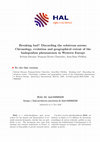
Quaternary International, 2021
The Badegoulian technocomplex holds a special place among the West European Upper Paleolithic (UP... more The Badegoulian technocomplex holds a special place among the West European Upper Paleolithic (UP) cultural traditions. Often understated or even bypassed by the main prehistorical overviews, caught between the fascinating Solutrean and the “classic” Magdalenian technocomplexes, it nonetheless probably marks a turning point in the evolving trajectory of hunter-gatherers in present-day France. The deep typo-technological changes, traditionally noted through lithic equipment, have recently been examined in the framework of interdisciplinary programs centered on several key-stratigraphic sequences located in south-west France. The combined analyses of flint, bone and antler assemblages, ornaments and faunal remains, together with the implementation of systematic archaeostratigraphic reassessment and radiometric dating, serve to confirm the speed and the strength of these changes ca. 23 cal ka BP. Without going into detail into the Solutrean-Badegoulian transition issue, the present pap...

Radiocarbon, 2020
Discovered at the beginning of the twentieth century, the Abri Casserole (Dordogne, France) was t... more Discovered at the beginning of the twentieth century, the Abri Casserole (Dordogne, France) was the subject of salvage excavations in the early nineties. The fieldwork revealed a sequence of 13 archaeological levels that document human occupations from the Gravettian to the Magdalenian, including very rare and poorly known assemblages (e.g. Early Badegoulian, Protosolutrean) that afford a particular importance to this sequence. Results of a previous dating program that focused on the Badegoulian levels were obtained in 1994 but were neither extensively published nor discussed. Five AMS 14C ages obtained for the Gravettian and Solutrean assemblages in the early 2010s served to complement the site’s chronology. However, since the beta counting ages for the Badegoulian levels were in conflict with the accepted AMS chronology for the region’s late Pleniglacial archaeological record, a new AMS dating program was implemented to renew the radiometric framework of this specific portion of the sequence. Compared to the previous beta counting measurements, the seven newly obtained AMS ages are about 1000 years older (23.3–20.5 cal ka BP) and congruent with other AMS dated Badegoulian sequences. These results thereby restore the inter site chronological coherence of the Solutrean–Badegoulian and Badegoulian–Magdalenian transitions.
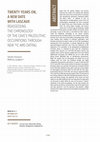
Paleo, 2019
Aside from the stylistic debates and quarrels fueled by the studies of its painted and engraved w... more Aside from the stylistic debates and quarrels fueled by the studies of its painted and engraved walls, the Lascaux Cave stands out by its very weak and contradictory radiometric framework (Delluc and Delluc 2012). In addition to this, no comprehensive, interdisciplinary study of the rich archaeological assemblages has been conducted for almost forty years (Leroi-Gourhan and Allain 1979). The LAsCO project (Langlais and Ducasse coord.) aims to fill this gap by proposing a global reassessment of the osseous and lithic artifacts, ornaments, ochres and lamps. As part of this work, a new effort has been made to clarify the Paleolithic chronology of the human activities documented by this stratified evidence. Five reindeer remains taken from the cave’s main areas (Axial Gallery, Passageway, Nave, Shaft), some showing clear evidence of anthropic exploitation, were therefore selected to be dated in order to test (1) the chronological homogeneity of the occupations, as already suggested by a high typo-technological coherence and, if this was confirmed, (2) the hypothesis of an attribution to the Badegoulian-to-Magdalenian transition phase, as indicated by prior inter-site comparisons (Langlais 2010 ; Ducasse et al. 2011; DEX_TER project: Ducasse and Langlais coord.). All the selected samples were sent to the Oxford Radiocarbon Accelerator Unit (ORAU) and run on a MIni CArbon DAting System (MICADAS) after an ultrafiltration pretreatment. While the sample from the Passageway area failed due to low collagen yield, the other four produced reliable and highly comparable measurements centered on a 14C age of 17,600 uncal. BP (21.5-21 cal ka BP). These results confirm the two basic assumptions described above and contradict the diachronic framework defined by the 1948-2002 radiometric data, while restoring a certain degree of chronological consistency which fits well with the main typo-technological features of the lithic and osseous equipment (Allain 1979, Leroy-Prost 2008 and ongoing analysis). After a brief outline of the existing radiometric data and a detailed description of the sampling and dating strategy, the reliability of the results and their impact on our understanding of the cave’s phase(s) of occupation(s) are discussed in depth. While the issue of the precise “cultural” attribution of the dated assemblages and the links between the latter and the parietal art are beyond the scope of this paper, these new data represent a first but significant step towards a global renewal of the highly controversial chronological framework of the Lascaux Cave.

Quaternary Science Reviews, 2019
Investigations of chronology play a key role in the majority of archaeological research endeavors... more Investigations of chronology play a key role in the majority of archaeological research endeavors and are particularly pertinent to examinations of culture-environment relationships, especially during periods characterized by rapid and marked climatic variability and environmental reorganization. Rigorous evaluations of available data and robust methods are required if one wishes to reconstruct reliable chronologies, and this is especially the case when examining periods that are associated with a relatively few radiometric measurements. Such is the case for the Upper Paleolithic archaeological record documented in present-day France from 32,000 to 21,000 calibrated years BP. We take into account critically examined radiocarbon measurements from contextually secure archaeological contexts and employ a recently-developed method of Hierarchical Bayesian Modeling to reconstruct the chronology of archaeological cultures from the Middle Gravettian to the Badegoulian. The calculated chronological 2 intervals for each typo-technologically defined culture phase are compared to the Greenland ice core climatic record and a terrestrial paleoenvironmental record from Bergsee Lake (Southern Germany)-itself expressed in calendar years calculated with the same calibration curve employed in our age model-thereby permitting each archaeological culture to be correlated accurately with documented paleoclimatic variability.

Journal of Archaeological Science: Reports, 2019
During the Last Glacial Maximum (LGM), very specific but rare osseous decorated artifacts were pr... more During the Last Glacial Maximum (LGM), very specific but rare osseous decorated artifacts were produced using the “pseudo-excise” technique. These artifacts present a large geographical distribution, extending at least from the Aquitaine basin to Asturias. While in France a Badegoulian age is traditionally accepted for the “pseudo-excise” technique, this is mostly based on arguable data from old excavations and/or problematic archaeostratigraphic contexts. Since it is a key-site for this matter we have focused our attention on Pégourié Cave (Lot, France) in order to establish the chronocultural attribution of pseudo-excised pieces in southwest France. The interdisciplinary reassessment of the lithic and osseous industries from Layer 8 and 9, including inter-layer refittings, has shown (1) the irrelevance of previous stratigraphic subdivisions and (2) the strong cultural heterogeneity of this assemblage, which combines Azilian, Magdalenian, Badegoulian, Solutrean and Gravettian components. At the same time, a broad 14C program based on the direct dating of specific bone and antler technical wastes and tools—including a pseudo-excised point—was implemented after 3D recording using photogrammetry. The results obtained have allowed us to establish a new, firm confirmation of the Badegoulian age of pseudo-excised decoration and, in doing so, to more precisely define the time-range of this specific feature's trans-regional dissemination. Finally, by comparing the results with recent data notably obtained at Llonín cave (Asturias, Spain), new light has been shed on the cultural geography of southwestern Europe during the LGM, allowing us to discuss and fuel the still-controversial “Iberian Badegoulian” hypothesis.

Préhistoire du Sud-Ouest, 2017
La collection dite "de a Cave à Endives" (CàE ; ou collection David), mêlant industries lithiques... more La collection dite "de a Cave à Endives" (CàE ; ou collection David), mêlant industries lithiques, osseuses, élément de parure et faune, fut constituée par André David dans les environs de la grotte du Pech Merle dont il est l'inventeur. Après sa redécouverte au tout début des années 1990 et la publication d'une note concernant l'anneau ouvert en bois de renne qu'elle renferme, cette série, alors reliée à un gisement potentiellement situé au "Pech-Del-Mas", fit l’objet quelques années plus tard d’un premier article de synthèse. Ce travail, très essentiellement basé sur l'étude de l'industrie osseuse, permit à P. Raux et J.-L. Piel-Desruisseaux de discuter de l'homogénéité du matériel recueilli et d'émettre une première proposition d'attribution chronoculturelle (i. e. Magdalénien ancien ou moyen). À la fin des années 2000, en marge de l'étude du matériel lithique post-solutréen de la grotte voisine du Petit Cloup Barrat (PCB), un rapide diagnostic de la composante lithique de la "Cave à Endives" révéla la grande proximité litho-typo-technologique du matériel issu des deux assemblages. Renforcée par l'existence, au Petit Cloup Barrat, de sondages antérieurs aux fouilles actuelles et partiellement attribués à A. David, l'hypothèse d’une origine commune se devait d'être discutée. Ainsi, dans le cadre du PCR "SaM", une réévaluation de l'intégralité de la collection fut entreprise et assortie de plusieurs datations 14C sur objets finis et déchets techniques en bois de renne. Le présent article détaille les principaux résultats de ce travail collectif, résultats qui viennent compléter, et dans certains cas nuancer, les interprétations proposées jusqu'ici.
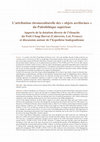
Bulletin de la Société préhistorique française, 2017
La couche 4 du Petit Cloup Barrat (Cabrerets, Lot) a livré une probable ébauche d'objet arciforme... more La couche 4 du Petit Cloup Barrat (Cabrerets, Lot) a livré une probable ébauche d'objet arciforme (ou « anneau ouvert ») en bois de cervidé. Ce morphotype n'était jusqu'à présent connu qu'au travers des dix exemplaires mis au jour dans la grotte du Placard (Vilhonneur, Charente) et de celui de la série dite de la « Cave à Endives » (collection André-David, Cabrerets, Lot). Sa datation directe par SMA (17720 ± 90 BP, soit 21770-21122 cal. BP), réalisée au laboratoire d'Oxford, semble renvoyer, selon les cadres chronologiques aujourd'hui disponibles pour le Sud-Ouest français, aux traditions techniques badegouliennes. Cette datation est par ailleurs cohérente avec la mesure d'âge obte-nue au sein du même ensemble à partir d'un éclat de bois de renne débité par percussion lancée, déchet technique caractéristique de la méthode de production des supports au Badegoulien. Au-delà d'un nécessaire travail de critique archéostratigraphique de la couche 4 qui semble, d'après les données typo-technologiques et radiométriques, témoigner d'une diachronie insoupçonnée jusqu'ici (Magdalénien moyen, inférieur, Badegoulien et Solutréen), la datation directe de l'ébauche d'anneau ouvert du Petit Cloup Barrat et son examen technique apportent un complément important à l'étude de ce type d'objet. Ces résultats, étendus aux autres objets arciformes considérés jusqu'alors comme magdaléniens, constituent une première étape vers la re-contextualisation chronoculturelle d'un morphotype aussi rare qu'original. Mots-clés : objet arciforme, anneau ouvert, datation directe SMA, Paléolithique supérieur, Badegoulien, Magdalénien, industrie osseuse.
Le Petit Cloup Barrat cave (Cabrerets, Lot, France) is located on the hill of Pech Merle, 800 metres from the famous Palaeolithic art cave. It opens onto the edge of a collapsed doline of 500 m 2. Since 2003, the different excavations (by Castel and Chauvière, then by Castel) have revealed an important Upper Palaeolithic stratigraphy, with several archaeological assemblages. More than ten millennia have been recorded discontinuously in the various sedimentary complexes, with occupations dating from the end of the Gravettian to the Middle Magdalenian. Layer 4 of the deposit yielded an 'arciform object' rough-out (so-called 'omega-like shape open ring') made in antler. Until now, this morphotype was known only through the ten specimens discovered at the end of the 19th century in Le Placard cave (Vilhonneur Charente, France) and that of the so-called 'Cave à Endives' archaeological collection (André David collection, Cabrerets, Lot). The direct dating of this rough-out using the AMS radiocarbon method (17720 ± 90 BP or 21770–21122 cal. BP) was carried out in the Oxford laboratory. According to the chronological frameworks now available for southwestern France, it seems to refer to the Badegoulian technical traditions. The implications of the absolute chronological positioning of this original object are important, first on the scale of Le Petit Cloup Barrat, but also for the Upper Palaeolithic 'arciform objects'. At Le Petit Cloup Barrat, Badegoulian occupations have been identified since 2003 inside the cave, following the discovery of lithic and osseous remains (respectively raclettes and antler flakes). They were discovered in layer c8a1. This layer has a remarkable sedimentary signature and was dated by the AMS radiocarbon method from a faunal remain (18595 ± 150 BP or 22876–22101 cal. BP). The direct 14 C dating of the open ring fills a gap in the radiometric chronology of the outer area of the main excavation sector, confirming the presence of the Badegoulian, already suspected through the recurrent demonstration of lithic " markers " on the heart and bottom of layer 4. Moreover, the direct 14
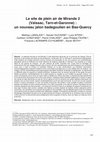
Le gisement de plein air de Mirande 2 a été récemment découvert sur la commune de Vaïssac (Tarn-e... more Le gisement de plein air de Mirande 2 a été récemment découvert sur la commune de Vaïssac (Tarn-et-Garonne), à une centaine de mètres du site de Mirande 1 fouillé entre 1971 et 1976 par R. Guicharnaud à Nègrepelisse. Cette opération de sondage préventif a permis d'évaluer les potentialités du site, d'en proposer une contextualisation géologique précise et d'exhumer les divers éléments de diagnose présentés ici. Mirande 2 est implanté sur un léger replat en rive gauche de l'Aveyron. Les trois secteurs de fouille (Tranchée Sud, Coupe Nord et Sondage) ont exclusivement livré des vestiges lithiques (silex et quartz) dont les caractéristiques typo-technologiques sont constantes d'une zone à l'autre et forment un ensemble cohérent sur le plan chronoculturel. Les premières observations archéostratigraphiques indiquent l'existence d'une concentration principale plus ou moins dilatée selon les secteurs. Les vestiges, dont les caractéristiques technotypologiques permettent d'attribuer l'ensemble au Badegoulien, se répartissent en différents types de supports et matières premières. Quelques blocs de trachyte façonnés et des galets de quartz débités proviennent vraisemblablement de la paléo-terrasse sur laquelle se sont installés les groupes humains. Les quartz sont présents sous la forme de macro-outils ou débités pour obtenir des éclats. L'essentiel des silex abandonnés sur le site provient des terrasses de la Vère et de l'Aveyron. Quelques indices tendraient également à montrer un apport de volumes en silex allochtones sur près de 100 km depuis le nord. En revanche, les autres matériaux allochtones sont présents sous la forme d'outils, signant vraisemblablement une fin de cycle fonctionnel. Du point de vue des supports d'outils à vocation domestique, on note une double composante. Des grattoirs, outils multiples et pièces à retouches latérales sont réalisés sur lame et éclats laminaires. Pour cette composante, et en l'état de l'analyse, l'hypothèse de deux schémas opératoires peut être proposée : une production laminaire cintrée et un débitage de supports envahissants sur face large. D'autres outils (racloirs, raclettes) sont réalisés sur éclats résultant de diverses chaînes opératoires parfois autonomes. Les microlithes sont composés de lamelles et micro-lamelles à dos de différents types et dont les supports sont produits à partir de rognons et éclats selon différentes modalités. Si le gisement de Mirande 2 constitue un nouveau témoignage d'occupations de plein air sur la paléo-terrasse de l'Aveyron, à proximité de sa confluence avec le Gouyré, il offre avant tout l'un des premiers jalons badegouliens entre Languedoc et Quercy, dans une région où il était peu connu jusqu'alors.

Bulletin de la Société préhistorique française, 2017
According to some, the first part of the Last Glacial Maximum (LGM: 23-19 ky cal. BP) in the Pyre... more According to some, the first part of the Last Glacial Maximum (LGM: 23-19 ky cal. BP) in the Pyrenees appears to be a singular moment when the cultural trajectory of hunter-gatherer groups diverged from the frameworks defined further north. Similar to the Upper Solutrean of the Vasco-Cantabrian area with which it shares several typo-technological specificities (e. g. concave-base points, Cantabrian-type shouldered points), the Solutrean of the Pyrenees would thus continue into the heart of the LGM (circa 21 ky cal. BP), parallel to the development of the Badegoulian traditions in the adjacent areas. The current scarcity or absence of Badegoulian sites throughout the Pyrenees fits well with this establishing of a cultural geography on the scale of South-Western France. However, the radiometric data used to support this model are currently questioned, while the age of the excavations on the LGM Pyrenees sequences and the impact of geomorphological processes on their degree of conservation can cause a skewed vision of this phenomenon. A collective and interdisciplinary reassessment of several key sites taking into account these biases was undertaken as part of the “SaM” project to discuss the reality of this palaeogeographical hypothesis on a new and firm basis.
In the wake of the recent work undertaken on Grotte des Scilles (Lespugue, Haute-Garonne) providing the first evidence of Lower Magdalenian settlement in the Pyrenees (second part of the LGM; circa 19.5 ky cal. BP), our research focused on the gorges of the Save. This canyon, carved in the limestone of the Pre-Pyrenees, has recorded a long-term and continuous human occupation thanks to several sequences from caves and rockshelters. In this rich Palaeolithic environment, Abri des Harpons (Lespugue, Haute-Garonne), excavated by R. de Saint-Périer from 1912 to 1930, attracted our attention. Besides layers from the historical periods, it reveals one of the longest Upper Palaeolithic sequences, comprised at least between the Early Solutrean and the Azilian. In the early 2000s the Upper Solutrean industries and faunal remains from layer D were reassessed by two of us (P. F. and C. S. J.-F.) providing new data on the Pyrenean Solutrean but demonstrating at the same time the heterogeneity of the assemblage on typological and radiometric bases. However, while this heterogeneity was circumscribed on a Solutrean scale (from the early to the upper/final phases), the discovery of several “raclettes typiques” raised questions, in addition to 14C dates more or less compatible with a Badegoulian chronology. In 2012, these elements led us to set up a new reassessment project with the aim of 1) evaluating the existence of a Badegoulian component in layer D, 2) carrying out a technological analysis of the Solutrean component to complete the typological and lithological data previously acquired, 3) searching for technological evidence of these two technocomplexes in the osseous industries and 4) renewing the radiometric framework through direct dating of several characteristic antler and bone waste products.
This work allowed us to confirm and enlarge the heterogeneity of the layer D assemblage: the Solutrean remains are clearly associated with Magdalenian, Gravettian and indisputably Badegoulian elements. Although the existing conditions of the Saint-Périer collections are a brake on the precise characterization of this Badegoulian component, these results allow us to contradict the idea that the Pyrenees were a no man’s land for the Badegoulian groups. If the question of the early expressions of this cultural tradition (i. e. Early Badegoulian) cannot be addressed from the Abri des Harpons data, we are now at least able to confirm the frequentation of the Pyrenees by holders of Recent Badegoulian technology as was suggested at Enlène cave (Montesquieu-Avantès, Ariège) in the 1980s through another mixed assemblage. Based on the comparison of the new AMS 14C dates with the most reliable data available in south-western France, we finally propose an alternative archaeostratigraphic framework of the Pyrenean LGM occupations that restores the role of the Badegoulian in regional palaeohistory and demonstrates a significant aging of the end of the Upper Solutrean (circa 23 ky cal. BP). These encouraging results should be supplemented by further analysis and will ultimately allow discussion of the nature and rhythm of the French Solutreo-Badegoulian transition outside the area of the classical definition of these two cultural traditions.



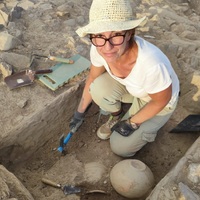







Uploads
Papers by Sylvain Ducasse
Le Petit Cloup Barrat cave (Cabrerets, Lot, France) is located on the hill of Pech Merle, 800 metres from the famous Palaeolithic art cave. It opens onto the edge of a collapsed doline of 500 m 2. Since 2003, the different excavations (by Castel and Chauvière, then by Castel) have revealed an important Upper Palaeolithic stratigraphy, with several archaeological assemblages. More than ten millennia have been recorded discontinuously in the various sedimentary complexes, with occupations dating from the end of the Gravettian to the Middle Magdalenian. Layer 4 of the deposit yielded an 'arciform object' rough-out (so-called 'omega-like shape open ring') made in antler. Until now, this morphotype was known only through the ten specimens discovered at the end of the 19th century in Le Placard cave (Vilhonneur Charente, France) and that of the so-called 'Cave à Endives' archaeological collection (André David collection, Cabrerets, Lot). The direct dating of this rough-out using the AMS radiocarbon method (17720 ± 90 BP or 21770–21122 cal. BP) was carried out in the Oxford laboratory. According to the chronological frameworks now available for southwestern France, it seems to refer to the Badegoulian technical traditions. The implications of the absolute chronological positioning of this original object are important, first on the scale of Le Petit Cloup Barrat, but also for the Upper Palaeolithic 'arciform objects'. At Le Petit Cloup Barrat, Badegoulian occupations have been identified since 2003 inside the cave, following the discovery of lithic and osseous remains (respectively raclettes and antler flakes). They were discovered in layer c8a1. This layer has a remarkable sedimentary signature and was dated by the AMS radiocarbon method from a faunal remain (18595 ± 150 BP or 22876–22101 cal. BP). The direct 14 C dating of the open ring fills a gap in the radiometric chronology of the outer area of the main excavation sector, confirming the presence of the Badegoulian, already suspected through the recurrent demonstration of lithic " markers " on the heart and bottom of layer 4. Moreover, the direct 14
In the wake of the recent work undertaken on Grotte des Scilles (Lespugue, Haute-Garonne) providing the first evidence of Lower Magdalenian settlement in the Pyrenees (second part of the LGM; circa 19.5 ky cal. BP), our research focused on the gorges of the Save. This canyon, carved in the limestone of the Pre-Pyrenees, has recorded a long-term and continuous human occupation thanks to several sequences from caves and rockshelters. In this rich Palaeolithic environment, Abri des Harpons (Lespugue, Haute-Garonne), excavated by R. de Saint-Périer from 1912 to 1930, attracted our attention. Besides layers from the historical periods, it reveals one of the longest Upper Palaeolithic sequences, comprised at least between the Early Solutrean and the Azilian. In the early 2000s the Upper Solutrean industries and faunal remains from layer D were reassessed by two of us (P. F. and C. S. J.-F.) providing new data on the Pyrenean Solutrean but demonstrating at the same time the heterogeneity of the assemblage on typological and radiometric bases. However, while this heterogeneity was circumscribed on a Solutrean scale (from the early to the upper/final phases), the discovery of several “raclettes typiques” raised questions, in addition to 14C dates more or less compatible with a Badegoulian chronology. In 2012, these elements led us to set up a new reassessment project with the aim of 1) evaluating the existence of a Badegoulian component in layer D, 2) carrying out a technological analysis of the Solutrean component to complete the typological and lithological data previously acquired, 3) searching for technological evidence of these two technocomplexes in the osseous industries and 4) renewing the radiometric framework through direct dating of several characteristic antler and bone waste products.
This work allowed us to confirm and enlarge the heterogeneity of the layer D assemblage: the Solutrean remains are clearly associated with Magdalenian, Gravettian and indisputably Badegoulian elements. Although the existing conditions of the Saint-Périer collections are a brake on the precise characterization of this Badegoulian component, these results allow us to contradict the idea that the Pyrenees were a no man’s land for the Badegoulian groups. If the question of the early expressions of this cultural tradition (i. e. Early Badegoulian) cannot be addressed from the Abri des Harpons data, we are now at least able to confirm the frequentation of the Pyrenees by holders of Recent Badegoulian technology as was suggested at Enlène cave (Montesquieu-Avantès, Ariège) in the 1980s through another mixed assemblage. Based on the comparison of the new AMS 14C dates with the most reliable data available in south-western France, we finally propose an alternative archaeostratigraphic framework of the Pyrenean LGM occupations that restores the role of the Badegoulian in regional palaeohistory and demonstrates a significant aging of the end of the Upper Solutrean (circa 23 ky cal. BP). These encouraging results should be supplemented by further analysis and will ultimately allow discussion of the nature and rhythm of the French Solutreo-Badegoulian transition outside the area of the classical definition of these two cultural traditions.
Le Petit Cloup Barrat cave (Cabrerets, Lot, France) is located on the hill of Pech Merle, 800 metres from the famous Palaeolithic art cave. It opens onto the edge of a collapsed doline of 500 m 2. Since 2003, the different excavations (by Castel and Chauvière, then by Castel) have revealed an important Upper Palaeolithic stratigraphy, with several archaeological assemblages. More than ten millennia have been recorded discontinuously in the various sedimentary complexes, with occupations dating from the end of the Gravettian to the Middle Magdalenian. Layer 4 of the deposit yielded an 'arciform object' rough-out (so-called 'omega-like shape open ring') made in antler. Until now, this morphotype was known only through the ten specimens discovered at the end of the 19th century in Le Placard cave (Vilhonneur Charente, France) and that of the so-called 'Cave à Endives' archaeological collection (André David collection, Cabrerets, Lot). The direct dating of this rough-out using the AMS radiocarbon method (17720 ± 90 BP or 21770–21122 cal. BP) was carried out in the Oxford laboratory. According to the chronological frameworks now available for southwestern France, it seems to refer to the Badegoulian technical traditions. The implications of the absolute chronological positioning of this original object are important, first on the scale of Le Petit Cloup Barrat, but also for the Upper Palaeolithic 'arciform objects'. At Le Petit Cloup Barrat, Badegoulian occupations have been identified since 2003 inside the cave, following the discovery of lithic and osseous remains (respectively raclettes and antler flakes). They were discovered in layer c8a1. This layer has a remarkable sedimentary signature and was dated by the AMS radiocarbon method from a faunal remain (18595 ± 150 BP or 22876–22101 cal. BP). The direct 14 C dating of the open ring fills a gap in the radiometric chronology of the outer area of the main excavation sector, confirming the presence of the Badegoulian, already suspected through the recurrent demonstration of lithic " markers " on the heart and bottom of layer 4. Moreover, the direct 14
In the wake of the recent work undertaken on Grotte des Scilles (Lespugue, Haute-Garonne) providing the first evidence of Lower Magdalenian settlement in the Pyrenees (second part of the LGM; circa 19.5 ky cal. BP), our research focused on the gorges of the Save. This canyon, carved in the limestone of the Pre-Pyrenees, has recorded a long-term and continuous human occupation thanks to several sequences from caves and rockshelters. In this rich Palaeolithic environment, Abri des Harpons (Lespugue, Haute-Garonne), excavated by R. de Saint-Périer from 1912 to 1930, attracted our attention. Besides layers from the historical periods, it reveals one of the longest Upper Palaeolithic sequences, comprised at least between the Early Solutrean and the Azilian. In the early 2000s the Upper Solutrean industries and faunal remains from layer D were reassessed by two of us (P. F. and C. S. J.-F.) providing new data on the Pyrenean Solutrean but demonstrating at the same time the heterogeneity of the assemblage on typological and radiometric bases. However, while this heterogeneity was circumscribed on a Solutrean scale (from the early to the upper/final phases), the discovery of several “raclettes typiques” raised questions, in addition to 14C dates more or less compatible with a Badegoulian chronology. In 2012, these elements led us to set up a new reassessment project with the aim of 1) evaluating the existence of a Badegoulian component in layer D, 2) carrying out a technological analysis of the Solutrean component to complete the typological and lithological data previously acquired, 3) searching for technological evidence of these two technocomplexes in the osseous industries and 4) renewing the radiometric framework through direct dating of several characteristic antler and bone waste products.
This work allowed us to confirm and enlarge the heterogeneity of the layer D assemblage: the Solutrean remains are clearly associated with Magdalenian, Gravettian and indisputably Badegoulian elements. Although the existing conditions of the Saint-Périer collections are a brake on the precise characterization of this Badegoulian component, these results allow us to contradict the idea that the Pyrenees were a no man’s land for the Badegoulian groups. If the question of the early expressions of this cultural tradition (i. e. Early Badegoulian) cannot be addressed from the Abri des Harpons data, we are now at least able to confirm the frequentation of the Pyrenees by holders of Recent Badegoulian technology as was suggested at Enlène cave (Montesquieu-Avantès, Ariège) in the 1980s through another mixed assemblage. Based on the comparison of the new AMS 14C dates with the most reliable data available in south-western France, we finally propose an alternative archaeostratigraphic framework of the Pyrenean LGM occupations that restores the role of the Badegoulian in regional palaeohistory and demonstrates a significant aging of the end of the Upper Solutrean (circa 23 ky cal. BP). These encouraging results should be supplemented by further analysis and will ultimately allow discussion of the nature and rhythm of the French Solutreo-Badegoulian transition outside the area of the classical definition of these two cultural traditions.
Research conducted in the framework of the “SaM” project since 2012 (S. Ducasse and C. Renard coord.) has addressed these issues via the interdisciplinary analysis of a large corpus of data. This corpus is derived from 20 sites located between the Charente, Landes and Aude regions, encompassing the Périgord/Quercy core area (tabl. 1). Depending on the nature of each archaeological context and site type (rockshelter/cave, N=17; open air site, N=3), we have constantly adapted our approach to ensure two basic points: the homogeneity of each studied assemblage (i. e., critical analyses of the stratigraphic sequences) and the availability of a renewed and robust radiometric framework. This last point led us to design a 14C dating program aimed at addressing both “taphonomic” and chronological issues, most notably through the direct dating of culturally diagnostic bone and antler technical waste and tools, whenever possible. From this point, assemblages are studied in a systemic manner that takes into account the entire technical system. Our approach, focused on the techno-economic relationships between the production of “domestic” tools and the production of hunting equipment (sensu Bon, 2009) allows us to discuss and compare the different strategies developed by Solutrean and Badegoulian groups. This, in turn, allows us to identify evolutionary trends. Once examined from a techno- and socio-economic perspective, the newly defined balances are discussed in regards to the changes documented in the symbolic component, thereby reinforcing the cultural significance of the transformations at work and allowing us to place our results in a paleohistorical perspective (sensu Valentin, 2008).
Although the results of the 14C program allow us (1) to define a chronological boundary around 23 kyr cal BP corresponding to a terminus post quem for the Upper Solutrean and (2) to place the Solutrean-to-Badegoulian transition (23.5-23 kyr cal BP) to the GI-2 interstadial (sensu Rasmussen et al., 2014), which was characterized by two abrupt warming events (GI 2.2 and 2.1) with a brief intervening stadial (GS 2.2), there is no local evidence of pronounced environmental changes between Upper Solutrean and Badegoulian - available data from archaeological sites and natural traps indicate, respectively, that the hunted and available fauna were identical. Thus, we can hypothesize that the use of very different hunting implements to procure game within the same or similar environmental contexts was related to more complex cultural factors rather than functional constraints.
Our interdisciplinary study shows that beyond a broad restructuring of the lithic and osseous array of tools, the Solutrean-to-Badegoulian transition is characterized by a significant reconfiguration of the techno-economical management of the productions and tools depending on their functional aim (i.e., “overinvestment” in the production of hunting tools and weapons in the Upper Solutrean versus equal investment regardless of the type of activity during the Badegoulian, notably expressed through a “ramification” of the chaînes opératoires – sensu Bourguignon et al. 2004). This reconfiguration is also expressed through clearly distinct anticipation strategies of needs based on a very distinct spatial-temporal segmentation of the chaînes opératoires, preferentially related to the hunting equipment during the Upper Solutrean, whereas it concerns both domestic and hunting equipment during the Badegoulian. We assume that this opposition between a techno-economical dissociation of needs on the one hand (Upper Solutrean model) and the fact that they are techno-economically intertwined on the other (Badegoulian model) could correspond to an opposition between various levels of the social segmentation of activities. At a broader, inter-site scale, one might well think that this varying degree of segmentation could also explain the perceptible differences relating to the various site types documented for each techno-complex: whereas we observe a possible site “complementarity” during the Upper Solutrean (i.e., lithic production sites, “hunting camps”, “base camps”, etc.) the Badegoulian seems to be characterized by a very similar pattern of occupation at all sites (i. e., occupations characterized by a diverse range of activities).
In the end, if we follow the line of thinking that the changes documented in the management of the lithic and osseous equipment, and more specifically hunting equipment, reflect changes in the groups social organization, all these transformations could reflect not only economical but also socio-symbolical changes (i. e., the various lines of evidence that support the hypothesis of a special sociological status for Solutrean hunters within the groups – see Pelegrin, 2007 and 2013; Renard et Geneste, 2006 – versus the absence of such evidence in the Badegoulian archaeological record). Such socio-symbolical changes are possibly suggested by the results of the ornaments study, which show a typo-technological reorganization between the end of the Solutrean and the Badegoulian that is defined by two coherent and distinct ensembles.
Data from natural traps sheds new light on human hunting strategies. In Quercy, for example, it has been shown that far from being rare, certain species that were not hunted were actually abundant in the surrounding area. Hunting is slightly more diversified in northern Aquitaine than in the south-east, and it seems probable that a large biomass was available throughout the regions studied. The choices made by hunters during the Recent Solutrean and the Badegoulian are, therefore, not simply a systematic exploitation of the entire animal biomass available. This information prompts a re-examination of our assumptions about human occupation strategies.
of Recent Badegoulian. It allows us, at the end, to lead a reflexion on the settlement dynamics and territory exploitation during this chronological phase.